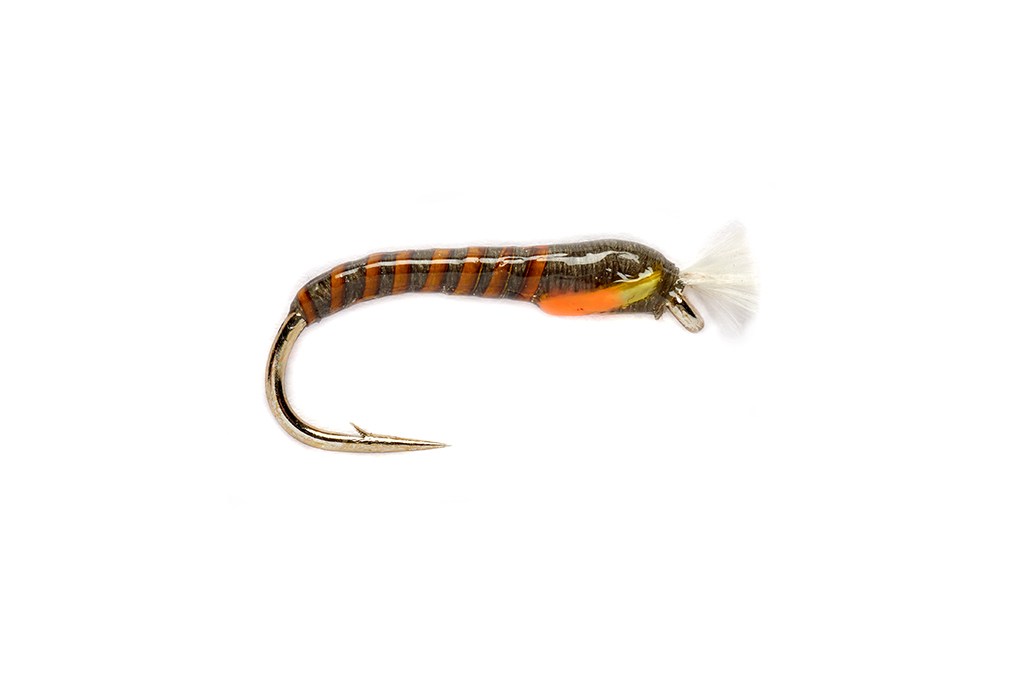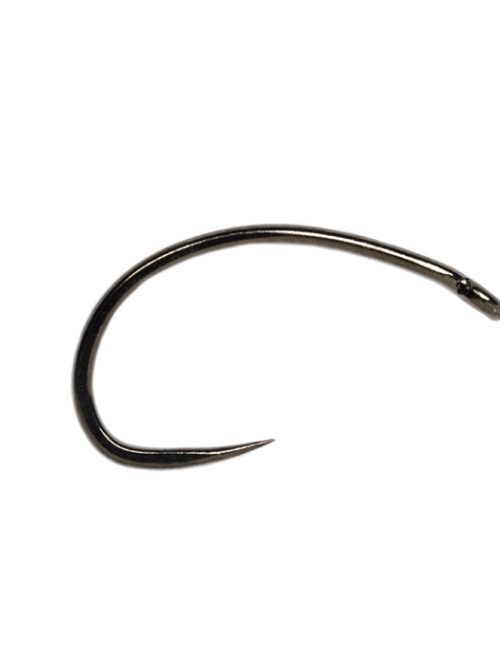The warmer months presents us anglers with the best and most consistent nymph fishing of the season. Nature flicks a switch in March to indicate the end of the cold winter weather and that spring has now arrived. With it comes huge hatches of buzzers. As always, the trout are always quick to feed on any plentiful food source, and these buzzers are no exception. As anglers it provides us with a distinct opportunity that we just cannot afford to miss. Throughout March, April, May and June you will be provided with a host of chances for that extra special “Red Letter Day” to catch grown on resident fish if you follow some simple steps on how to fish buzzers!

Patrick Tillard image.
The Natural Approach
Nymph fishing in general is often considered challenging as it is a “natural approach.” Leaders consist of multiple small flies, with little or no movement and are cast out in a huge expanse of open water. It can put off all but the most experienced anglers. In fact, I often hear the argument, “that won’t work, it’s too small, the fish will never see it”.
Please have just a little faith and try the following methods. Once you start catching on nymphs your confidence will rise exponentially.

What makes a good buzzer pattern?
A good buzzer fishing pattern should be lifelike and realistic. It should also have a subtle target point to attract the fish to your fly. This is to make it stand out from the other thousands of nymphs in the water. With buzzers, I always aim for a segmented body, and add the target point to the wing buds or thorax cover. For example, the Crank Shank Buzzer with its holographic orange wing case or my 2-Tone Quill Buzzer. Both patterns work very well and make the fly stand out by adding a subtle touch of brightness. However, you can go overboard with the target points. Too much bling and all you will catch is stockies that are drawn to the increased colour on the pattern.
I use patterns that remain lifelike with specific target points and triggers rather than an exact imitation. I do not want my fly to be identical to the other 1,000’s of naturals in the water. That said, it do want it to be very similar and natural looking. It’s a very fine line to get a pattern to stand out slightly and pull the fish to your cast rather than spook them with too much bling. I prefer a thin holo thorax cover or occasionally a fluro cheeks (but never both). As I previously mentioned bright fluorescent materials are most attractive to stockfish, and I feel it often puts off the larger resident fish.

Patrick Tillard image.
The Cast
Whether fishing the indicator or straight line nymphing I always place my brightest nymph pattern on the top dropper. This will attract and pull the fish to your flies as it catches the sunlight better. Obviously, it will attract stockies but it will also attract resident fish to the more natural patterns further down the cast. It doubles your chances as any fish investigating your pattern from depth must swim by the other natural flies on your cast twice (on the way up and down).

Patrick Tillard image.
When fishing buzzers the unwritten rule is that it’s best to have a light 5 – 9 mph left to right wind. This allows you to cast out and let your team of flies swing gently round in an arc. I fully accept it’s a very effective method but in my experience, it only tends to regularly catch fish up to 3lb.
I feel that by fishing across the wind my flies (although moving slowly) are actually often moving too fast and look un-natural to educated fish, so they simply don’t take. Conversely, stockies and well mended fish love that slight movement and change of direction as it induces the take. But for the largest grown-on fish 4lb+ fishing and presenting your flies “static” is undoubtably best in my experience.
Tackle to Fish Buzzers
When buzzer fishing, the most important components of your tackle are your flies and leader material. The leader should be clear, soft and supple usually in breaking strains of between 7 and 8 lb. The thinner leader material allows the angler to offer a better presentation of his flies, which when fishing slowly or static is far more important than when pulling. Every fault is highlighted when fishing slowly as the fish has more time to inspect your cast before taking your fly. Hence the reason it’s important to get things right. Personally, I have been using the new Fulling Mill Masterclass Fluorocarbon leader material for over 3 years in 3X 7.1lb as it’s very thin and the diameter to breaking strain ratio is excellent.

Patrick Tillard image.
Regarding flies, the following patterns are all that’s needed to be successful on any water large or small when fishing buzzers.
Crank Shank Buzzer Black
2 Tone Buzzer Black
Weighted Traffic Light Buzzer



In spring the most productive area for fishing buzzers is a band of water 10 – 60m off the bank with the depth of water approximately 6 to15ft. This is home to the buzzers. The nymphs will begin life on the bottom in the silt and mud. Then, they will then rise in the water and eventually hatch as the weather warms.
So, depending upon the temperature of the water, underwater currents and the surface tension the nymphs will be at a range of depths throughout the day. This is why the trout feed at a variety of depths, and why you catch on different droppers during the day.
By fishing multiple flies on a leader you can effectively cover a range of water. You are in effect increasing your chances by having flies at different depths.
There are essentially 3 different methods for fishing “Buzzers”
- The Bung or indicator
- “Straight line” buzzer fishing
- “Washing line” method
1: The Bung or indicator
The Bung is basically an indicator or float that suspends your flies perfectly at distinct depths. The biggest and heaviest fly, such as a weighted buzzer, is always fished on the point. When the fish want flies fished static this method can be absolutely deadly.
The length of your leader will vary. However, a standard bung set up will have 5ft to the Bung then 3.5ft to top dropper. Then, another 3.5ft to middle dropper and 3ft to the point. The total leader length is 15ft. The big advantage of having 5ft to the bung is that if you feel the fish are deeper and you are only catching on your point fly then you can simply take the bung off and replace it with another buzzer so allowing your whole cast to get deeper. This is now straight line buzzer fishing, which we will cover next.
With the bung, simply make a cast and leave everything static for 15 – 20 seconds. Watch your line in case it suddenly straightens indicating a fish has taken your flies “on the drop.” Once the flies have all sunk and are vertical, slowly figure of eight 2ft of line into the boat. Then, stop for 10 secs just keeping in contact with your flies. This does 2 things. First, it raises all of the flies in the water. Then, it lets them fall again. This is just as the natural nymph will act. Also, if fishing the bung it will cause a big disturbance on the surface, sometimes this can have the added bonus of attracting the trout to your flies.
Often the bung will dip just like a float allowing you to see any takes a split second before you feel them. It’s then just a simple case of lifting into the fish.

Patrick Tillard image.
2: Straight line buzzer fishing
Fishing this style is ideal for when you want to fish deeper than 12ft without the bung. A typical set up would be 6ft to the top dropper, 5ft to the middle dropper and 4ft to the point fly. The total leader length is 15ft . You can also do 4 flies each at 4ft, which is a 16ft leader. If you want to fish deeper simply use a midge tip instead of a floating line.
Again, the heaviest epoxy buzzer (or weighted buzzer) is fished on the point. This set up will actually drag the tip of the floating line down 2 or 3 ft, don’t worry, this is normal!
Just fish with an ultra-slow figure of 8 (occasionally a little faster) but before you recast if fishing from a boat remember the hang and drop back. The trout will follow buzzers and on occasion they will suddenly rush to take when there is movement.
Use the fly-line, leader and braided loop as an indicator. If you see any movement, strike.
TOP TIP: Buzzer fishing can be explosive, so hold the rod tip 2ft off the water. Watch the fly line for movement and lift firmly into a fish rather than striking.

Patrick Tillard image.
3: Washing Line Method
The “washing line” method is a generic term used to describe a floating point fly (usually a booby or popper hopper) with nymphs or buzzers on the droppers. It allows the angler to fish multiple flies in the killing zone.



Usually the method is used when fishing a floating, midge tip or Intermediate line when the fish are in the top 6ft of water. However, it can be equally effective on sinking lines.
It’s fairly obvious that the larger the booby eyes (or the foam in the popper hopper) then the higher the point fly will hold in the water.
Choosing the right tippet for the washing line
However, the type and diameter of leader material will play a huge part as to how your flies fish in the water. I tend to use co-polymer when the fish are high in the water. Conversely, I use fluorocarbon when the fish are below 2ft. The copolymer tippet doesn’t sink as fast as fluorocarbon, so will hold higher in the water. Fluorocarbon is heavier than copolymer so will drag the flies down somewhat.
The length of leader and spacing’s of flies will also drastically effect how deep your setup fishes. For example a fluorocarbon leader with 7 – 10ft to the top dropper then 2 further droppers spaced 3.5ft apart with a size 12 small eyed booby on the point and size 10 buzzers on the droppers will allow the angler to fish deeper than most anglers imagine, depths of 20ft are achievable with a slow retrieve in calm conditions.
The size and type of fly will have a huge effect on how the leader fishes. Epoxy buzzers will sink fast and skinny. A Seal’s fur or pheasant tail buzzer will sink slower. A size 10 fly tied on heavy wire hooks will drag the cast down, including the point fly, which allows you to fish the drop.

Patrick Tillard image.
The retrieve
Make a long cast, then make 2 pulls and strip the flies. This will straighten the leader and ensure that you are in direct contact with your cast. In turn, this allows you to feel the slightest of takes. It will also cause the floating point fly to “pop” across the surface, which will draw fish to your flies. They will investigate the disturbance
All that’s needed then is an ultra-slow figure of 8. Basically just keep in contact with your flies (if fishing on the drop) or retrieving them at a slow pace. All your flies will be held at the correct depth for longer, so increasing your chances.
I find that buzzer fishing in this way is most successful once the water has warmed up, and the fish are on the move. On overcast days I consider it the most consistent method for catching Stillwater trout feeding in the top 6ft of the water column. The slow retrieve allows you to essentially fish a lure (the booby) and buzzers on the same cast; it increases your options as it allows you to fish two different styles of flies at the same time. The patterns complement each other perfectly all you have to do is a little fine-tuning to the method and get the depth right.
To read more from Rob Edmunds, check out his other articles on our blog.






